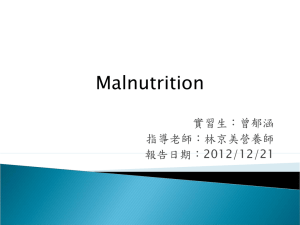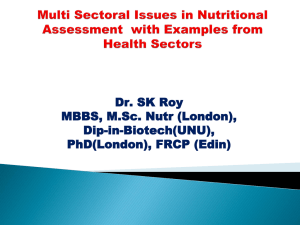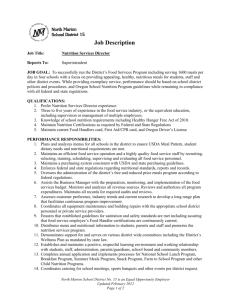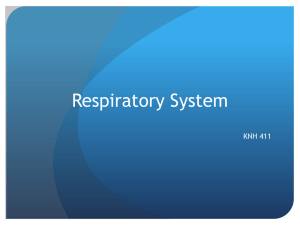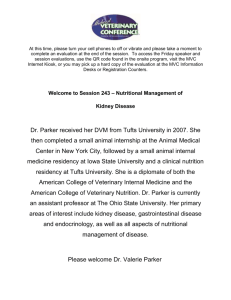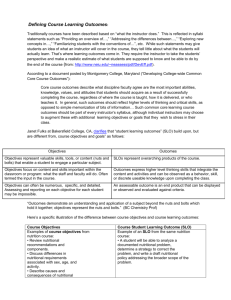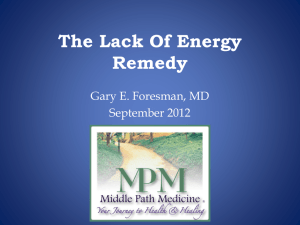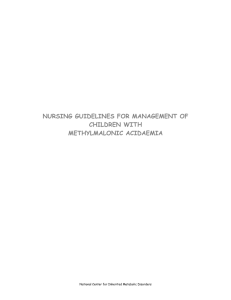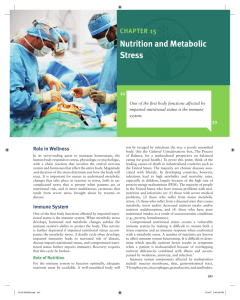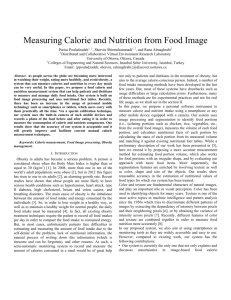metabolic or respiratory chapter 16
advertisement
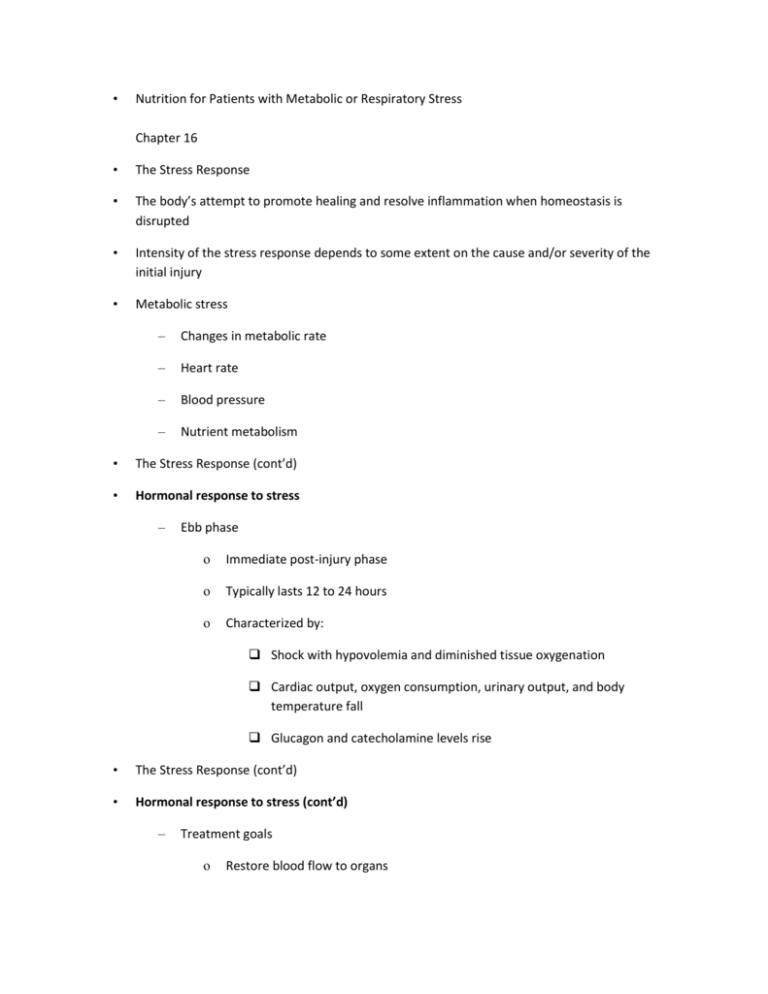
• Nutrition for Patients with Metabolic or Respiratory Stress Chapter 16 • The Stress Response • The body’s attempt to promote healing and resolve inflammation when homeostasis is disrupted • Intensity of the stress response depends to some extent on the cause and/or severity of the initial injury • Metabolic stress – Changes in metabolic rate – Heart rate – Blood pressure – Nutrient metabolism • The Stress Response (cont’d) • Hormonal response to stress – Ebb phase o Immediate post-injury phase o Typically lasts 12 to 24 hours o Characterized by: Shock with hypovolemia and diminished tissue oxygenation Cardiac output, oxygen consumption, urinary output, and body temperature fall Glucagon and catecholamine levels rise • The Stress Response (cont’d) • Hormonal response to stress (cont’d) – Treatment goals o Restore blood flow to organs – o Maintain adequate oxygenation to all tissues o Stop bleeding Ebb phase ends when the patient is hemodynamically stable • The Stress Response (cont’d) • Hormonal response to stress (cont’d) – Flow phase o Metabolic response to stress o Counterregulatory hormones Makes energy available to carry on essential bodily functions • o State of hypercatabolism and hypermetabolism created o The Stress Response (cont’d) Hormonal response to stress (cont’d) – Flow phase (cont’d) o Oxygen consumption, cardiac output, carbon dioxide production, and body temperature increase o Length of phase depends on: Severity of injury or infection Development of complications • – Glycogen is depleted within the first 24 hours after the injury – The Stress Response (cont’d) Inflammatory response – Acute-phase response o Body’s attempt to destroy infectious agents and prevent further tissue damage o Characterized by a change of at least 25% in the plasma concentration of certain proteins known as acute phase proteins C-reactive protein is positive protein Negative acute phase proteins decrease in response to inflammation; albumin is one example • The Stress Response (cont’d) • Inflammatory response – Acute-phase response (cont’d) o Cytokines and other immune system molecules Regulate acute phase proteins Produce changes in other cells that cause systemic symptoms of inflammation – • Anorexia Fever Lethargy Weight loss The Stress Response (cont’d) Inflammatory response (cont’d) – Systemic inflammatory response syndrome (SIRS) o Life-threatening condition o May occur when severe inflammation lasts longer than a few days o Heart rate, respiratory rate, white blood cell count, and/or body temperature become critically elevated o If caused by infection, sepsis may occur • The Stress Response (cont’d) • Inflammatory response (cont’d) – Systemic inflammatory response syndrome (SIRS) (cont’d) o SIRS and sepsis cause: Excessive fluid accumulation Low blood pressure Impaired blood flow o – Inadequate oxygenation of tissues can lead to shock and multiple organ failure Patient’s prior nutritional status is an important predictor or morbidity and mortality • The Stress Response (cont’d) • Nutritional needs – Considered after the patient is hemodynamically stable – Overwhelming nutritional concern during metabolic stress is protein catabolism o – Can lead to impaired immune system functioning, increased risk of infection, impaired or delayed wound healing, and increased mortality Primary goal of nutrition therapy is to protect lean body mass and prevent or alleviate malnutrition • The Stress Response (cont’d) • Nutritional needs (cont’d) – Calories o Indirect calorimetry is rarely used o Harris–Benedict equation is not for the critically ill o Basal energy expenditure (BEE) o Multiply the patient’s weight in kilograms by a specified calorie level Adjusted upward or downward based on the patient’s response • The Stress Response (cont’d) • Calories (cont’d) – Underfeeding o Excessive calorie intake increases metabolism, oxygen consumption, and carbon dioxide production Increases the burden already placed on the heart and lungs to regulate blood gases Refeeding syndrome • The Stress Response (cont’d) • Underfeeding (cont’d) – Feeding critically ill patients at 100% of calculated need is associated with worse, not better, clinical outcomes – Underfeeding during critical illness (80% calories) is associated with shorter ICU and hospital stays – Modest calorie intake is also associated with a higher chance of achieving ventilator independence before leaving the ICU – Hypocaloric intake is maintained for 3 to 5 days • The Stress Response (cont’d) • Nutritional needs (cont’d) – Protein o Recommendations for protein are not universally agreed upon Range from 1.0 g/kg to 2.0 g/kg Patients with severe burns may need 2 to 2.5 g/ kg o Specific types of amino acids given may influence the stress response and recovery Arginine and glutamine, two nonessential amino acids, may become conditionally essential during periods of stress • The Stress Response (cont’d) • Nutritional needs (cont’d) – – Carbohydrates and fat o Should provide 50% to 60% of total calorie needs o Fat may provide up to 40% of total calories Fluid o Highly individualized requirements according to losses that occur through exudates, hemorrhage, emesis, diuresis, diarrhea, and fever o Avoid overhydration o – • Decreased renal output is a frequent complication of metabolic stress The Stress Response (cont’d) Nutritional needs (cont’d) – Micronutrients o Vitamin and mineral requirements during stress are unclear o Trauma and burn patients have been documented to have high urinary and tissue losses of the trace elements selenium, zinc, and copper When replaced: Patients experienced significantly fewer infections Wound healing also improved • The Stress Response (cont’d) • Method of feeding – Enteral nutrition (EN) is recommended over parenteral nutrition (PN) in critically ill patients who are hemodynamically stable and have a functional GI tract o – Common complication in critically ill patients is gastroparesis Parenteral nutrition is required when the GI tract is nonfunctional o Associated with increased rate of hyperglycemia • The Stress Response (cont’d) • Method of feeding (cont’d) – Oral diets are provided as soon as possible – Nutrition support—either complete or supplemental tube feedings—is necessary when calorie needs are not met through an oral intake • Burns • Extensive burns are the most severe form of metabolic stress • Fluid and electrolyte replacement to maintain adequate blood volume and blood pressure are the priorities of the initial post-burn period • Degree of hypermetabolism and hypercatabolism in the metabolic response phase correlates to the extent of burn • Burns (cont’d) • Nutrition therapy – Priority is to meet calorie and protein needs o Protein needs are typically 2.0 to 2.5 g/kg Especially if burns cover more than 10% of total body surface area o Calorie and protein needs increase if complications develop o Vitamin C, vitamin A, and zinc, plus a multivitamin, are recommended by the Shriners Burn Institute • Burns (cont’d) • Nutrition therapy (cont’d) – Develop less gastroparesis when they are given nasogastric or nasoduodenal tube feedings within 8 to 12 hours after admission – When oral intake is less than 75% of estimated need for over 3 days, EN should be used for total or supplemental nutrition – Total parenteral nutrition is used with extreme caution • Respiratory Stress • Occurs when gas exchange between the air and blood is impaired • May cause hypermetabolism • When nutritional needs are not met, fewer nutrients are available to maintain respiratory muscle function • Chronic or acute respiratory stress can lead to: • – Respiratory failure – Multiple organ failure – Death Respiratory Stress (cont’d) • Chronic obstructive pulmonary disease – As many as 60% of patients with chronic obstructive pulmonary disease (COPD) have malnutrition, which is associated with poor outcomes – Many patients with COPD are hypermetabolic – Chronic inflammation – Anorexia may occur – Early satiety • Respiratory Stress (cont’d) • Chronic obstructive pulmonary disease (cont’d) – Nutrition therapy o Correcting or preventing malnutrition is the priority o High-calorie, high-protein diet is used o Some patients may be overweight from steroid use o For patients hospitalized with exacerbation of COPD, calorie needs may be 140% above BEE o Protein need may be 1.2 g/kg body weight • Ventilator Dependency and Carbohydrate Restriction • Patients on ventilator support may benefit from a restricted carbohydrate intake – Carbohydrates produce more carbon dioxide when they are metabolized than do either proteins or fats – This creates a greater burden on the lungs • Promoting Maximum Intake in Patients Whose Needs Are High and Appetite Is Low • Work with client and family to solicit food preferences • Young children may regress in their eating behaviors • Adults may prefer foods they associate with recovery as children (e.g., chicken soup) • When TPN May Be Necessary • For patients with: – Adynamic ileus – Intractable diarrhea – Bleeding related to Curling’s ulcer – Pancreatitis – Pseudoobstruction of the colon – Patients who cannot receive tube feedings for longer than 2 to 3 days


